Thunderstorm, lightning, and means of protection of the power grid on its own
According to the results of the May thunderstorms, it was necessary to conduct an audit of the burnt equipment and although the damage was not so great materially, but the failure of some equipment violated the well-established comfort of living in their own house. So I decided to contact the experts in my field, consult and expand the protection system.
Initial data: house, 3 phases (15 kW per house), grounding with a pin 3 m long, autonomous electrical system based on solar panels
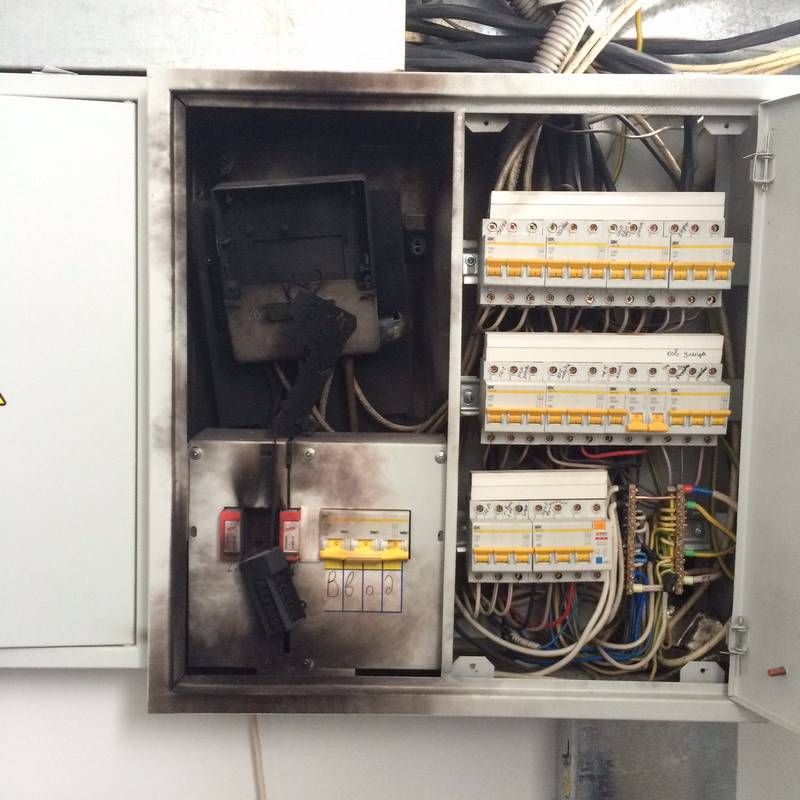
')
The photo shows the result of a short circuit on the side of the 10 kV line. Protection did not work at the district substation. This is the introduction shield from the 0.4KV side. Automatic IEK at 100A could not break the arc between the jaws. Further along the line was MAP HYBRID 9kW 48V . We got off with a slight fright: the varistor was changed in the inverter, after which the MAP came to life, however, the RS232 port stopped working normally. That is, a serious accident at the substation, which burned an automatic fuse for 100 Amp, affected the inverter only with a burned-out varistor and errors on the controller, and all other functionality of the device was preserved, as well as all the equipment connected after it - praiseworthy work.
And below on the photo of the metering station from the 10 KV
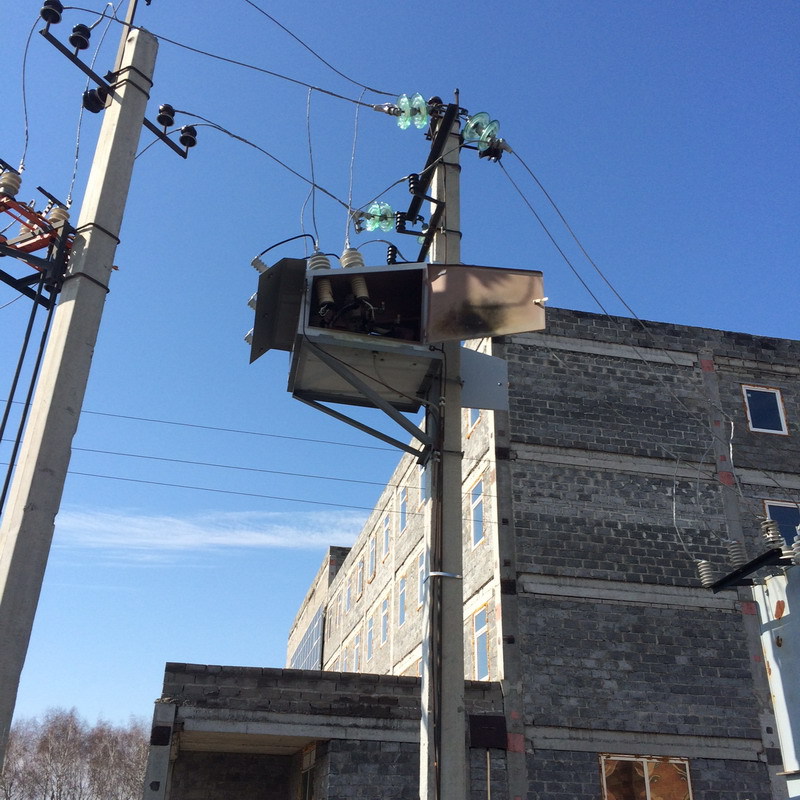
This accident did not happen in my house, but these photos were passed on to me by the specialists of the MicroART company. At one time, I decided to switch to the equipment of a Russian manufacturer for my hybrid solar-grid electrical system and described these devices here and here .
I also had the following case: during a thunderstorm, lightning struck at my substation or near it, as a result of which I worked out the protection at the entrance to the house. The result of that thunderstorm was a burned-out battery charger connected to the network at the time of a thunderstorm, a blown ventilation relay (the relay was powered from the line supported by the charger), and the MAP Hybrid 4.5 kW inverter started blinking on the screen and stopped generating. After a thunderstorm, restarting all systems returned the house to the power supply, the inverter started up without problems, and I thought about the serious protection of the home power grid.
Some theory
During a thunderstorm in a normal apartment or office building must work out the protection installed by a fixed electrical network. In a cottage settlement, in a village or at dachas, protection is usually limited to a dug ground at the substation and a fuse that shuts off the entire network from work. Moreover, according to the rules of connection, grounding should be mounted also on every second pole and separately on the final one, where the subscriber house is connected. Having walked through my village and examined more than fifty pillars, I did not find a single grounding, that is, it remains to rely only on myself.
The second "deadly" factor is induced electricity. During lightning, a rather powerful burst of electromagnetic radiation occurs, and the house wiring is, in fact, a large antenna. The closer the lightning, the greater the likelihood of a voltage surge in the internal network. The installers of the house LANs constantly faced and continue to face this phenomenon, when the switches without grounding, during a thunderstorm, burn down in whole chains.
So, we need to protect ourselves from an external impulse that can come from a substation and from an internal surge that can happen when a lightning strikes near the house.
Practice
Lightning rod
If your house is on an elevation, far from any buildings and is the highest point on the ground, then it is better to attend to a lightning rod. The device is reliable, but it is necessary to clearly calculate the area of coverage. On this subject there is a mass of materials in the network. I can only say that the action of the lightning conductor is propagated by a cone from the highest point to the ground. For the "cover" of the whole house, it is necessary to put either two lightning rods with a metal cable between them, or one, but rather high. If the grounding of the lightning conductor is made separately from the general grounding, then it is necessary to apply a potential equalization system.
Excerpts from the INSTRUCTIONS ON THE DEVICE OF LIGHTNESS PROTECTION OF BUILDINGS AND STRUCTURES RD 34.21.122-87:
"It is allowed to use all the recommended earthing switches as earthing switches for lightning protection
electrical installations, with the exception of the neutral wires of overhead transmission lines with voltage up to 1 kV. „
“2.5. To exclude the introduction of high potential into the protected building or structure, but underground
metal communications (including over electrical cables for any purpose) grounding protection against
direct lightning strikes should be as far away as possible from these communications,
permissible according to technological requirements. „
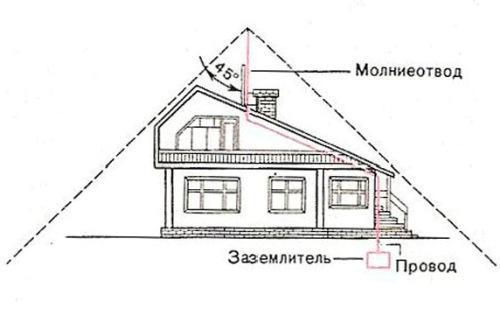
Entering the network into the house
The danger of introducing high voltage is terrible not only in a thunderstorm, but also when the wires overlap on poles or a large phase misalignment. It is common for village electric grids when the voltage across the phases can be 180, 200 and 240 V. GOST allows power supply with voltage deviation up to 10% (if exactly, + 10% and -15%) from the norm of 220 V, i.e. from 187 to 242 V. But not all supplied equipment can withstand such voltage drops. For normal protection it is best to use voltage regulators. And there are three-phase and single-phase stabilizers. Most often, three single-phase stabilizers will work better than one three-phase stabilizer, if only because the simplest devices monitor the voltage in one phase and the change (increase or decrease) in voltage occurs in all three. Simplified: when the voltage rises from 180 to 220 V, the voltage on the other phase will increase from 210 to 250 V, which is fraught with the equipment. Therefore, tracking of each phase will be more reliable. In addition, there are several types of stabilizers:
The first one has a high accuracy of voltage setting, since the motor slides with the carrier on the windings and sets the required voltage. Pros: low price, high accuracy of the output voltage. Minuses: low reaction rate to power surges, physical wear and tear of mechanics
The second one has an increased switching speed of the transformer windings, but since the power can reach ten or more kW, the relay contactors wear out and sooner or later can stick, which will lead to dire consequences. Pros: reasonable price, sufficient switching speed. Cons: lack of reliability due to the use of mechanical relays.
The third type is the most interesting, but also the most expensive. The use of powerful keys allows you to instantly respond to changes in input voltage and switch the transformer windings. Physical wear and tearing of contacts is simply not there. In addition, switching occurs when the sine passes through zero, and therefore jumps are also excluded. Pros: high response speed, no physical wear. Cons: high price.
For myself, I chose a more expensive, but also more reliable option, a stabilizer with a triac control CH-LCD “Energy” of 6 kW . Since I already have a 4.5 kW inverter, which at its peak can produce up to 7 kW, it was decided to choose a stabilizer with a rated power of 6 kW and the ability to output at a peak up to 7.4 kW.

About the features of the work of these stabilizers and what stabilizers in general can be found in detail here .
Well, it was interesting to me to disassemble it and see what was inside.
As can be seen from the photo, the stabilizer uses a toroidal transformer, which, with the same dimensions as the W-shaped one, has more efficiency and less weight. The transformer itself is made in Tula, and the stabilizer is designed and assembled in Moscow. Thus, it is possible to safely declare about fully Russian production, which we were able to organize and keep in the company MicroART.
So, I was insured against subsidence and voltage rise in the range of 125-275 Volts, but what if there is a sharp voltage surge, which is much beyond these limits? The inverter somehow showed me in phase 287 V, after which he went into defense. But feed him 380 V and it will simply burn, as does the stabilizer. I wanted to protect expensive equipment. Some kind of trip unit was required that would disconnect the external network at voltage thresholds. It is better to be left without a network than to repair or change the burned equipment. The output was found - the relay control network voltage UZM-51M1 .

This device is designed to ensure the operation of a single phase, and you can manually set the upper and lower voltage thresholds at which the relay will operate. Off time is about 20 ms, which is a very good indicator. At the same time, small drawdowns or some overvoltage will not cause instantaneous shutdown, and the sleep timer will start. When the parameters return to normal, the relay will independently connect the load to the network. So, home devices are protected from surges and surges in the external power grid using a voltage control relay and a stabilizer. In case of network disappearance, the inverter starts working. What to do if the external network is already disconnected, the lightning strikes nearby and the house wiring works like an antenna?
Internal network protection
We will proceed from the fact that all sockets have the correct wiring, the grounding is done properly and an extra charge flows into the ground. But the power surge in the internal network easily ruins all the equipment, since all the protections are for defense against external surges. But from the internal interference there is nothing. With this in mind, I turned to the MicroART engineers when I took away the stabilizer and I was recommended the "Lightning and interference protection device" - SPD .
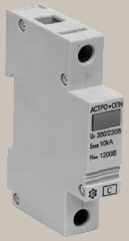
This is a kind of arrester, which, when a critical voltage appears between the phase and the earth, passes a pulse through itself, sending it to ground. That is, during a thunderstorm, when lightning strikes nearby and the voltage in the home network rises to several kilovolts along a phase wire relative to the ground and exceeds a certain value, this arrester will simply put the entire charge into the ground. Therefore, it is placed in front of the inverter, connecting one end to the phase and the other to grounding. It should be noted that the discharge can be significant, so you should not save on the cross-section of the grounding wire, otherwise the resistance of the wire can be critical and not have time to transfer a pulse to the ground.
This is how the connection to the external network and the generator is made:
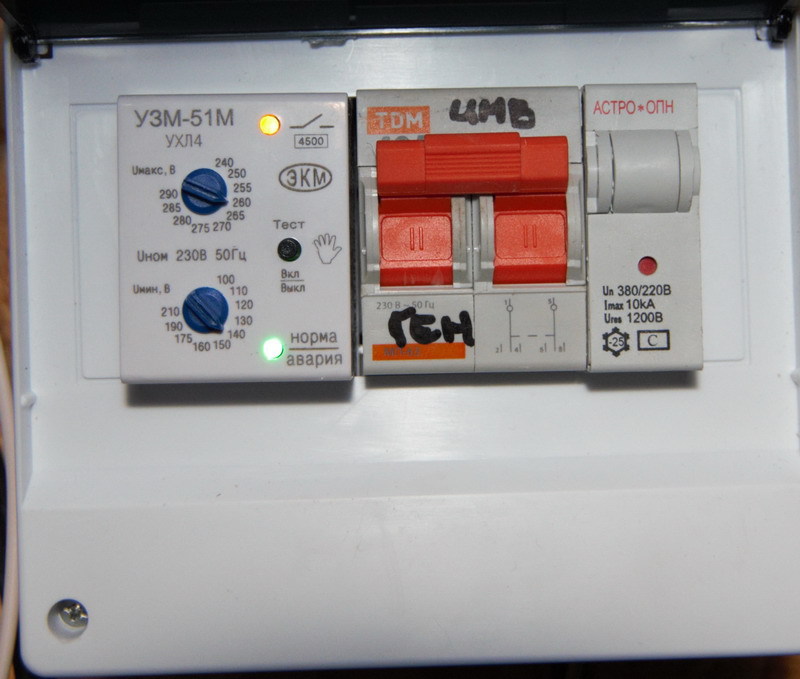
I have already mentioned that I have an autonomous solar system. By wires coming from solar panels, a serious impulse can also come, disabling the solar controller, and behind it the inverter. Therefore, on each of the wires from the solar panels, I also hung up a surge protection device.
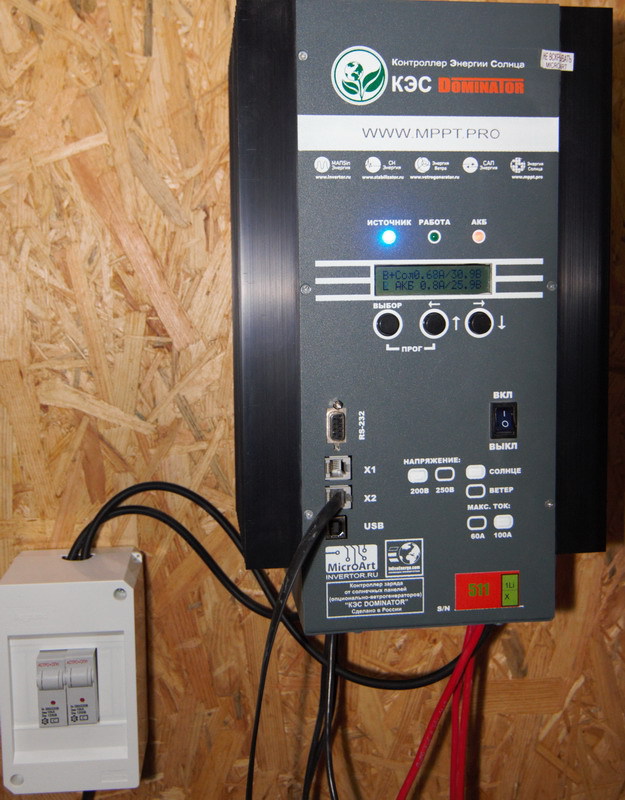
Generator protection
In the most emergency case, when there is no external network, the sun is not visible, and the batteries have already sat down, all autonomous workers have a backup option - a benzo / diesel generator. It will allow the home network to function, to work itself with a powerful tool, and even recharge the batteries. I described a similar reservation topology in my material here . The problem with this connection is that most generators provide extremely unstable and "noisy" power. Sometimes inverters or chargers simply can not work with such power. To suppress interference there is a special surge protector. You can do with a standard “pilot”, but it is designed, as a rule, for power up to 2-3 kW, and more often is consumed from the generator. So, I also found an EMP (Electromagnetic Pulse) filter: Surge suppressor EMF .
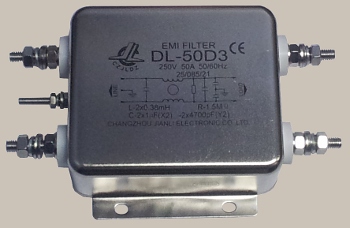
It can withstand the power consumption of up to 11 kW, which is quite enough to power the whole house, if there is a powerful generator. It has an end-to-end connection and a separate grounding contact.
Results of the work
The result of one thunderstorm and small losses was a rethinking of the methods of protection, both from external energy collisions, and from internal ones. In addition, increased security of all electrical appliances in the house, both from voltage surges, and from sudden surges and pulses. Additionally, the autonomy increased due to the connection of the generator through the filter, which guarantees a stable battery charge and normal operation of the inverter.
As a result, the electrical system has changed. Before:
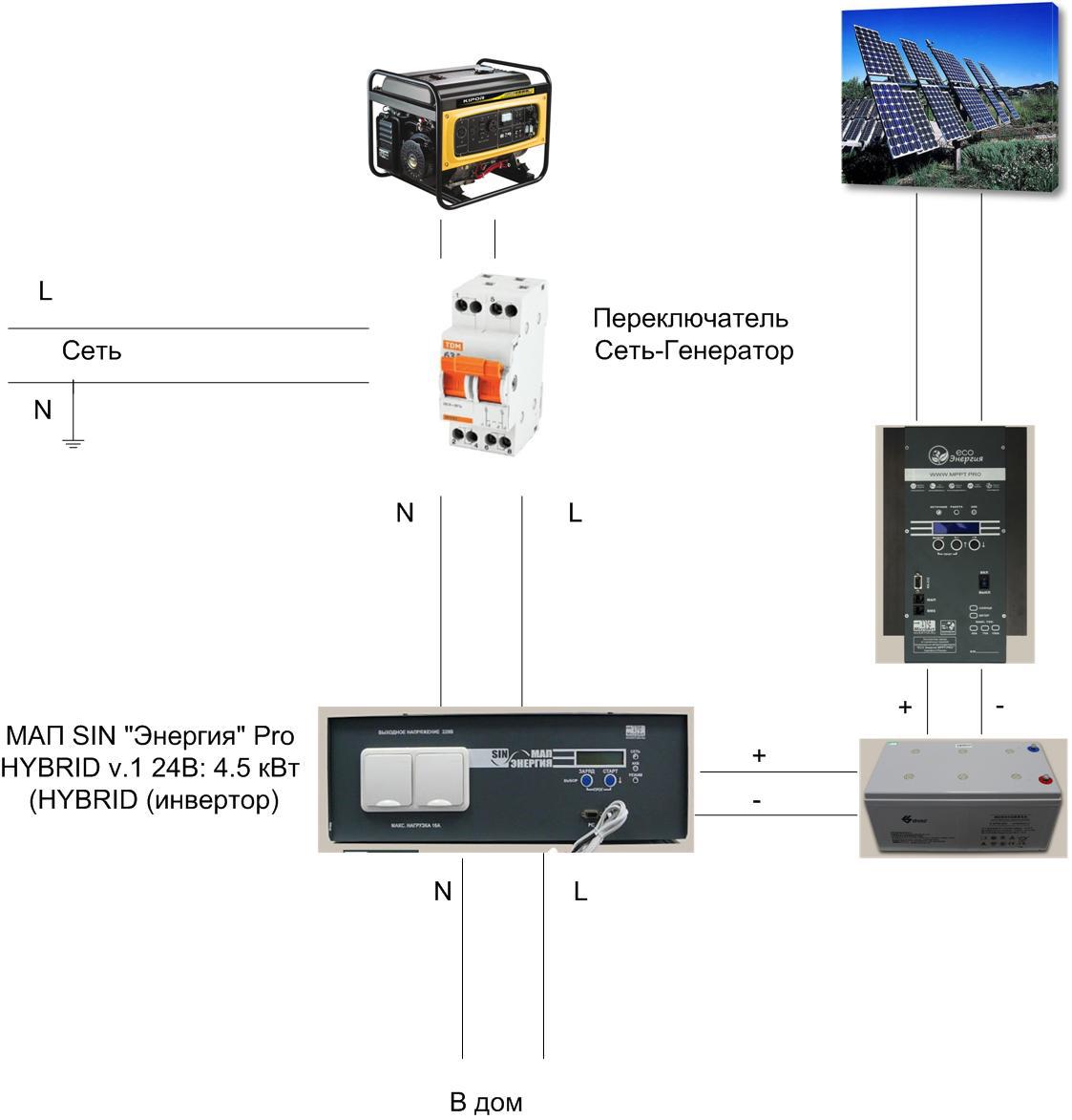
So it became AFTER the installation of protection:

The generator wiring diagram is quite simple. Any of the wires combined with the available land and zero, brought into the house. The second wire then becomes the phase. It is important to choose a switch that will exclude the simultaneous closure of the generator phase and the phase from the substation.
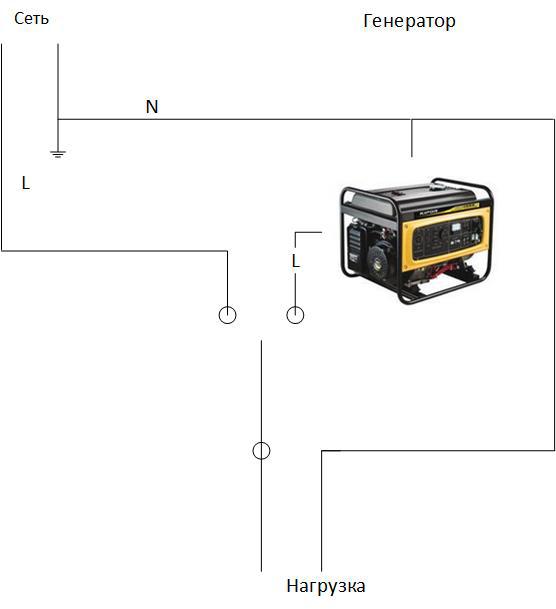
The first launch of the entire system looked like this:
Initial data: house, 3 phases (15 kW per house), grounding with a pin 3 m long, autonomous electrical system based on solar panels

')
The photo shows the result of a short circuit on the side of the 10 kV line. Protection did not work at the district substation. This is the introduction shield from the 0.4KV side. Automatic IEK at 100A could not break the arc between the jaws. Further along the line was MAP HYBRID 9kW 48V . We got off with a slight fright: the varistor was changed in the inverter, after which the MAP came to life, however, the RS232 port stopped working normally. That is, a serious accident at the substation, which burned an automatic fuse for 100 Amp, affected the inverter only with a burned-out varistor and errors on the controller, and all other functionality of the device was preserved, as well as all the equipment connected after it - praiseworthy work.
And below on the photo of the metering station from the 10 KV

This accident did not happen in my house, but these photos were passed on to me by the specialists of the MicroART company. At one time, I decided to switch to the equipment of a Russian manufacturer for my hybrid solar-grid electrical system and described these devices here and here .
I also had the following case: during a thunderstorm, lightning struck at my substation or near it, as a result of which I worked out the protection at the entrance to the house. The result of that thunderstorm was a burned-out battery charger connected to the network at the time of a thunderstorm, a blown ventilation relay (the relay was powered from the line supported by the charger), and the MAP Hybrid 4.5 kW inverter started blinking on the screen and stopped generating. After a thunderstorm, restarting all systems returned the house to the power supply, the inverter started up without problems, and I thought about the serious protection of the home power grid.
Some theory
During a thunderstorm in a normal apartment or office building must work out the protection installed by a fixed electrical network. In a cottage settlement, in a village or at dachas, protection is usually limited to a dug ground at the substation and a fuse that shuts off the entire network from work. Moreover, according to the rules of connection, grounding should be mounted also on every second pole and separately on the final one, where the subscriber house is connected. Having walked through my village and examined more than fifty pillars, I did not find a single grounding, that is, it remains to rely only on myself.
The second "deadly" factor is induced electricity. During lightning, a rather powerful burst of electromagnetic radiation occurs, and the house wiring is, in fact, a large antenna. The closer the lightning, the greater the likelihood of a voltage surge in the internal network. The installers of the house LANs constantly faced and continue to face this phenomenon, when the switches without grounding, during a thunderstorm, burn down in whole chains.
So, we need to protect ourselves from an external impulse that can come from a substation and from an internal surge that can happen when a lightning strikes near the house.
Practice
Lightning rod
If your house is on an elevation, far from any buildings and is the highest point on the ground, then it is better to attend to a lightning rod. The device is reliable, but it is necessary to clearly calculate the area of coverage. On this subject there is a mass of materials in the network. I can only say that the action of the lightning conductor is propagated by a cone from the highest point to the ground. For the "cover" of the whole house, it is necessary to put either two lightning rods with a metal cable between them, or one, but rather high. If the grounding of the lightning conductor is made separately from the general grounding, then it is necessary to apply a potential equalization system.
Excerpts from the INSTRUCTIONS ON THE DEVICE OF LIGHTNESS PROTECTION OF BUILDINGS AND STRUCTURES RD 34.21.122-87:
"It is allowed to use all the recommended earthing switches as earthing switches for lightning protection
electrical installations, with the exception of the neutral wires of overhead transmission lines with voltage up to 1 kV. „
“2.5. To exclude the introduction of high potential into the protected building or structure, but underground
metal communications (including over electrical cables for any purpose) grounding protection against
direct lightning strikes should be as far away as possible from these communications,
permissible according to technological requirements. „

Entering the network into the house
The danger of introducing high voltage is terrible not only in a thunderstorm, but also when the wires overlap on poles or a large phase misalignment. It is common for village electric grids when the voltage across the phases can be 180, 200 and 240 V. GOST allows power supply with voltage deviation up to 10% (if exactly, + 10% and -15%) from the norm of 220 V, i.e. from 187 to 242 V. But not all supplied equipment can withstand such voltage drops. For normal protection it is best to use voltage regulators. And there are three-phase and single-phase stabilizers. Most often, three single-phase stabilizers will work better than one three-phase stabilizer, if only because the simplest devices monitor the voltage in one phase and the change (increase or decrease) in voltage occurs in all three. Simplified: when the voltage rises from 180 to 220 V, the voltage on the other phase will increase from 210 to 250 V, which is fraught with the equipment. Therefore, tracking of each phase will be more reliable. In addition, there are several types of stabilizers:
- Latra
- Relay
- Triac
The first one has a high accuracy of voltage setting, since the motor slides with the carrier on the windings and sets the required voltage. Pros: low price, high accuracy of the output voltage. Minuses: low reaction rate to power surges, physical wear and tear of mechanics
The second one has an increased switching speed of the transformer windings, but since the power can reach ten or more kW, the relay contactors wear out and sooner or later can stick, which will lead to dire consequences. Pros: reasonable price, sufficient switching speed. Cons: lack of reliability due to the use of mechanical relays.
The third type is the most interesting, but also the most expensive. The use of powerful keys allows you to instantly respond to changes in input voltage and switch the transformer windings. Physical wear and tearing of contacts is simply not there. In addition, switching occurs when the sine passes through zero, and therefore jumps are also excluded. Pros: high response speed, no physical wear. Cons: high price.
For myself, I chose a more expensive, but also more reliable option, a stabilizer with a triac control CH-LCD “Energy” of 6 kW . Since I already have a 4.5 kW inverter, which at its peak can produce up to 7 kW, it was decided to choose a stabilizer with a rated power of 6 kW and the ability to output at a peak up to 7.4 kW.

About the features of the work of these stabilizers and what stabilizers in general can be found in detail here .
Well, it was interesting to me to disassemble it and see what was inside.
Opening the stabilizer showed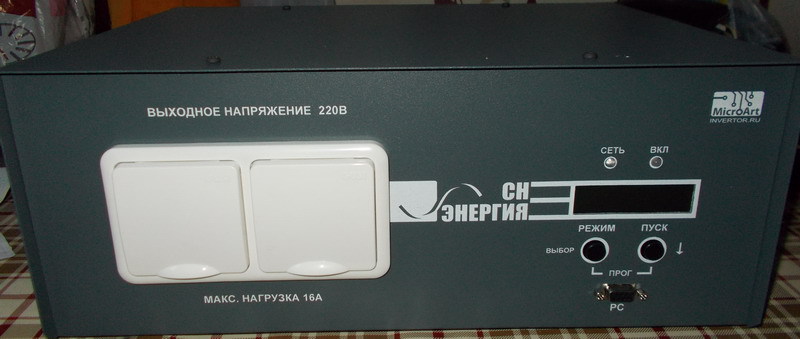
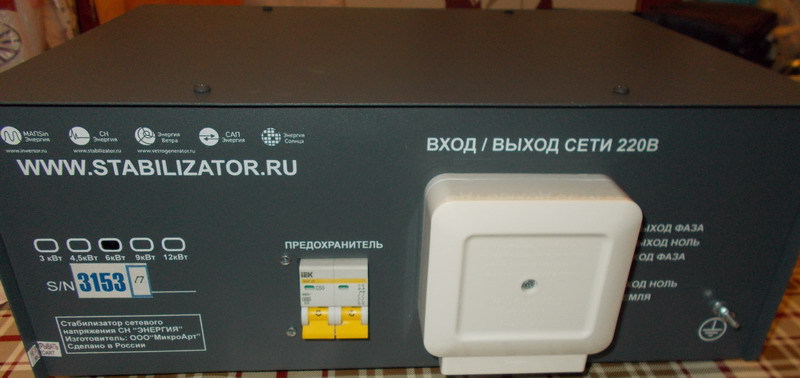
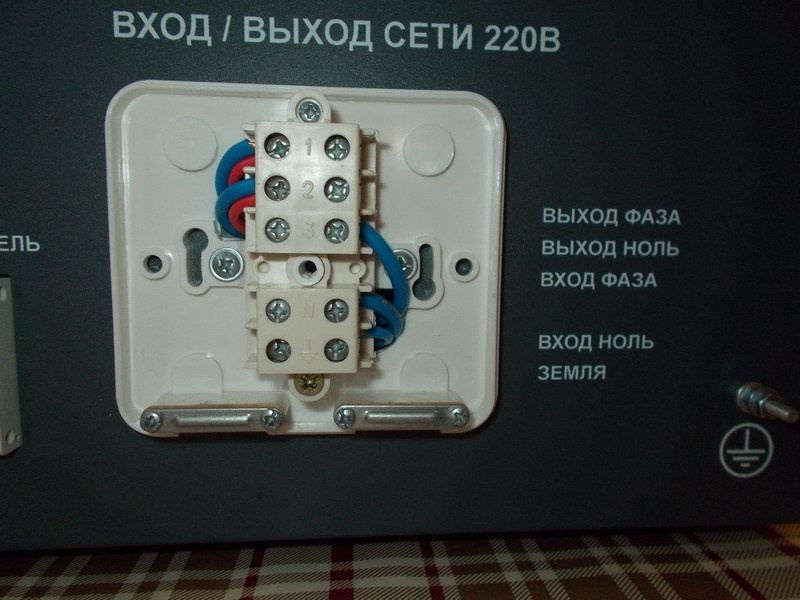

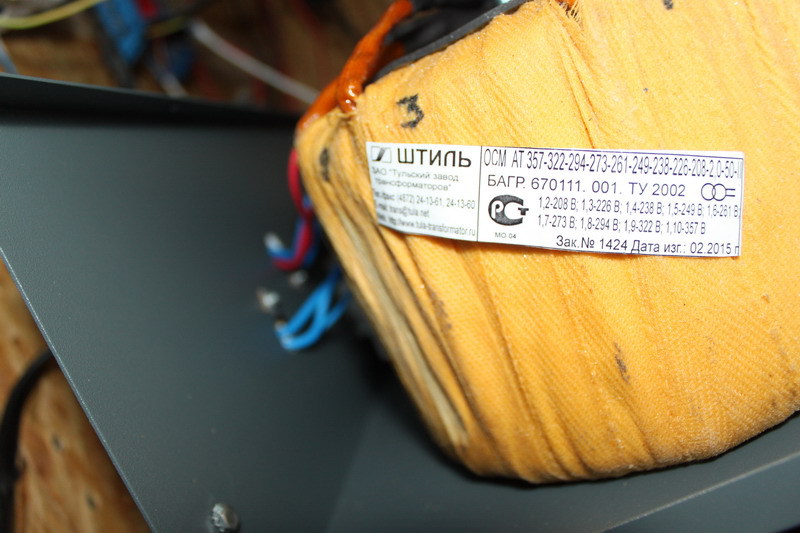





As can be seen from the photo, the stabilizer uses a toroidal transformer, which, with the same dimensions as the W-shaped one, has more efficiency and less weight. The transformer itself is made in Tula, and the stabilizer is designed and assembled in Moscow. Thus, it is possible to safely declare about fully Russian production, which we were able to organize and keep in the company MicroART.
So, I was insured against subsidence and voltage rise in the range of 125-275 Volts, but what if there is a sharp voltage surge, which is much beyond these limits? The inverter somehow showed me in phase 287 V, after which he went into defense. But feed him 380 V and it will simply burn, as does the stabilizer. I wanted to protect expensive equipment. Some kind of trip unit was required that would disconnect the external network at voltage thresholds. It is better to be left without a network than to repair or change the burned equipment. The output was found - the relay control network voltage UZM-51M1 .

This device is designed to ensure the operation of a single phase, and you can manually set the upper and lower voltage thresholds at which the relay will operate. Off time is about 20 ms, which is a very good indicator. At the same time, small drawdowns or some overvoltage will not cause instantaneous shutdown, and the sleep timer will start. When the parameters return to normal, the relay will independently connect the load to the network. So, home devices are protected from surges and surges in the external power grid using a voltage control relay and a stabilizer. In case of network disappearance, the inverter starts working. What to do if the external network is already disconnected, the lightning strikes nearby and the house wiring works like an antenna?
Internal network protection
We will proceed from the fact that all sockets have the correct wiring, the grounding is done properly and an extra charge flows into the ground. But the power surge in the internal network easily ruins all the equipment, since all the protections are for defense against external surges. But from the internal interference there is nothing. With this in mind, I turned to the MicroART engineers when I took away the stabilizer and I was recommended the "Lightning and interference protection device" - SPD .

This is a kind of arrester, which, when a critical voltage appears between the phase and the earth, passes a pulse through itself, sending it to ground. That is, during a thunderstorm, when lightning strikes nearby and the voltage in the home network rises to several kilovolts along a phase wire relative to the ground and exceeds a certain value, this arrester will simply put the entire charge into the ground. Therefore, it is placed in front of the inverter, connecting one end to the phase and the other to grounding. It should be noted that the discharge can be significant, so you should not save on the cross-section of the grounding wire, otherwise the resistance of the wire can be critical and not have time to transfer a pulse to the ground.
This is how the connection to the external network and the generator is made:

I have already mentioned that I have an autonomous solar system. By wires coming from solar panels, a serious impulse can also come, disabling the solar controller, and behind it the inverter. Therefore, on each of the wires from the solar panels, I also hung up a surge protection device.

Generator protection
In the most emergency case, when there is no external network, the sun is not visible, and the batteries have already sat down, all autonomous workers have a backup option - a benzo / diesel generator. It will allow the home network to function, to work itself with a powerful tool, and even recharge the batteries. I described a similar reservation topology in my material here . The problem with this connection is that most generators provide extremely unstable and "noisy" power. Sometimes inverters or chargers simply can not work with such power. To suppress interference there is a special surge protector. You can do with a standard “pilot”, but it is designed, as a rule, for power up to 2-3 kW, and more often is consumed from the generator. So, I also found an EMP (Electromagnetic Pulse) filter: Surge suppressor EMF .

It can withstand the power consumption of up to 11 kW, which is quite enough to power the whole house, if there is a powerful generator. It has an end-to-end connection and a separate grounding contact.
Results of the work
The result of one thunderstorm and small losses was a rethinking of the methods of protection, both from external energy collisions, and from internal ones. In addition, increased security of all electrical appliances in the house, both from voltage surges, and from sudden surges and pulses. Additionally, the autonomy increased due to the connection of the generator through the filter, which guarantees a stable battery charge and normal operation of the inverter.
As a result, the electrical system has changed. Before:

So it became AFTER the installation of protection:

The generator wiring diagram is quite simple. Any of the wires combined with the available land and zero, brought into the house. The second wire then becomes the phase. It is important to choose a switch that will exclude the simultaneous closure of the generator phase and the phase from the substation.

The first launch of the entire system looked like this:
Source: https://habr.com/ru/post/260737/
All Articles